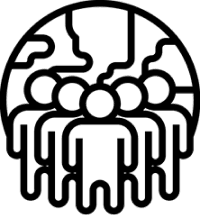EAC and Environment & Natural Resources
The East African Community is endowed with various natural resources such as forests, water, wildlife, mountains, minerals and energy resources. The natural resources are the drivers of national and regional economic development. The objective of the Environment and Natural Resources Management sector is to promote sustainable use and management of natural resources and promote adaptation to climate change. Articles 111, 112 and 114 of the EAC Treaty provide for cooperation in environment and natural resources. The EAC Partner States have agreed to take joint effort to cooperate in efficient management of these resources. Key priorities of the sector include Climate Change adaptation and mitigation, natural resource management and biodiversity conservation, disaster risk reduction and management, and pollution control and waste management. The sector is strengthening the resilience and sustainable management of biologically significant trans-boundary freshwater ecosystems; supporting adaptive capacities and resilience to the negative impacts of Climate Change; developing and harmonising standards, framework and regulation on pollution control and waste management; and, strengthening Disaster Risk Reduction management and policy.
The German Government supports this EAC Sector as cooperation outside the Core Area of EAC-German cooperation as defined by BMZ 2030 – in the area of “Conserving Nature and Natural Resources, Protecting Life on Earth” in the Intervention Area “Water”. The cooperation directly contributes to implement three of the eight priority areas defined by the 6th EAC Development Strategy, namely “Development of Regional Infrastructure”, “Institutional Transformation” and “Awareness Creation”. The BMZ 2030 reform strategy focuses on a new quality of cooperation. More information on BMZ 2030 can be found here.

Environment & Natural Resources
EAC-Germany Support

Integrated Water Resources Management in the EAC
The EAC includes several transboundary river basins as well as the lakes Victoria, Tanganyika, Albert, Edward, Kivu, Turkana and Nyasa. Lake Victoria is the second largest freshwater lake in the world and the largest in the region. Around one third of the EAC's water resources are located in Lake Victoria Basin (LVB), where 45 million people live, around 30% of the EAC's inhabitants. Its surface is shared by Kenya (6%), Uganda (45%) and Tanzania (49%), but the basin extends to Rwanda and Burundi. The Basin has been declared an economic growth zone by the EAC. The pressure on the water resources is increased by the steadily growing population and the rapid economic development in the region. As a result, the water quality in the LVB deteriorates. In addition, effects of climate change are likely to cause more irregular rainfall and lead to more droughts and floods in the basin. The EAC has created the Lake Victoria Basin Commission (LVBC) as a subsidiary institution through an EAC protocol ratified in 2004 for the sustainable development of the Lake Victoria Basin. One of the objectives of LVBC is to promote sustainable utilisation and management of natural resources, which includes integrated water resources management.
Projects:
LVBC IWRM (GIZ)
Objective: Institutional framework conditions for integrated management of transboundary water resources in the East African community are improved.
Approach: The project assists the EAC Secretariat and its specialized organisation, the Lake Victoria Basin Commission (LVBC) located in Kisumu in promotion of sustainable economic use and environmental protection of the EAC’s water resources, with a focus on the Lake Victoria Basin, based on appropriate regional frameworks and effective Integrated Water Resources Management (IWRM) institutions. LVBC’s capacities to carry out its core function of LVBC in IWRM shall be strengthened, as well as horizontal cooperation and knowledge management between the LVBC and key IWRM actors responsible for water resources in the Lake Victoria Basin. Interventions focus on:
- Promotion of IWRM and environmental topics within EAC political agenda.
- Development of the EAC Water Framework Directive and relevant legal instruments and compliance mechanisms.
- Support to LVBC in harmonisation of policies, laws, standards (e.g. lake level, water quality, catchment protection)
- Support to LVBC in resources mobilization to strengthen its core functions and for IWRM projects
- Intensify horizontal cooperation between LVBC and Partner Sates, their basin organisations and research institutions.
- Provide technical capacity development for national basin organisations (e.g. on implementation of guidelines on collection, analysis, processing of data and feed it in the Water Information System).
- Prepare ready to finance IWRM projects.
Women who are primarily responsible for supplying their families with water are often insufficiently involved in decision-making processes and are clearly underrepresented in the public and (formal) private sector. Therefore, the project specifically targets women and youth in its activities.
Find more information on the LVBC-IWRM project here.
LVB IWRMP (KfW)
Objective: Water quality and availability is improved through sustainable management of the Lake Victoria Basin
Approach: The LVB IWRMP works towards its objective by (1) strengthening the long-term strategic, regional water resources management function of the LVBC Secretariat and by (2) implementing (regional) investments and awareness campaigns in order to reduce effluence into Lake Victoria and increase access to sanitation. Investments include:
- Construction of a faecal sludge treatment plant in Kigali, Rwanda
- Construction of multi-household wash houses and sewer systems for informal settlements in Kisumu, Kenya
- Expansion of sewer network in Mwanza, Tanzania
- In preparation: Rehabilitation/construction of sewer system in Luzira catchment area in Kampala, Uganda
Find more information on the LVB-IWRM here.